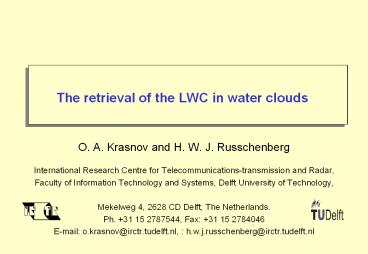The retrieval of the LWC in water clouds - PowerPoint PPT Presentation
1 / 34
Title:
The retrieval of the LWC in water clouds
Description:
Faculty of Information Technology and Systems, Delft University ... Merlin flight. Frisch Z-LWC relations after adding 13 dB to Z. September 23, 2001, Z 13 dBZ ... – PowerPoint PPT presentation
Number of Views:29
Avg rating:3.0/5.0
Title: The retrieval of the LWC in water clouds
1
The retrieval of the LWC in water clouds
- O. A. Krasnov and H. W. J. Russchenberg
- International Research Centre for
Telecommunications-transmission and Radar, - Faculty of Information Technology and Systems,
Delft University of Technology, - Mekelweg 4, 2628 CD Delft, The Netherlands.
- Ph. 31 15 2787544, Fax 31 15 2784046
- E-mail o.krasnov_at_irctr.tudelft.nl,
h.w.j.russchenberg_at_irctr.tudelft.nl
2
Radar reflectivity
Liquid water content
Dropsize distribution
Very sensitive to tail of dsd
Are power laws useful?
3
drizzle
transition drizzle
A million droplets of 10 micron give the same
radar reflection as one droplet of 100 micron!
A million droplets of 10 micron contain a
thousand times as much water as one one droplet
of 100 micron...
And so one drizzle droplet changes the
reflectivity significantly without changing the
liquid water content
non-drizzling
4
Common opinion No, there is too much scatter due
to drizzle
unless
we can identify the drizzle droplets somehow...
5
Techniques for identification
- Radar reflection
- Separation based on differences in reflectivity
of drizzle - and non-drizzling clouds
- High resolution Doppler radar
- Separation based on differences in fall speeds
- Radar lidar combination
- Separation based on differences in sensitivity of
reflection - on droplet size
6
Radar reflection
Drizzling
Non-drizzling
Coarse classification
7
Radar and lidar observables in relation to
microphysical water cloud.
Radar-lidar ratio vs effective radius
Radar reflectivity vs liquid water content
8
The Radar, Lidar, and Radiometer datasetfrom the
Baltex Bridge Cloud (BBC) campaign August 1-
September 30, 2001, Cabauw, NL
- Radar Reflectivity from the 95 GHz Radar MIRACLE
(GKSS) - Lidar Backscattering Coefficient from the CT75K
Lidar Ceilometer (KNMI) - Liquid Water Path from the 22 channel MICCY
(UBonn) - All data were presented in equal time-height grid
with time interval 30 sec and height interval 30
m.
9
Case study August 28, 2001, Cabauw, NL,
10.12-11.20 The profiles of measured variables
10
Case study August 28, 2001, Cabauw, NL,
10.12-11.20 The profiles of Optical Extinction
and Radar-Lidar Ratio
11
Z1 -20 dBZ, Z2 -10 dBZ thresholds for radar
only
12
0 dB
13
5 dB
14
10 dB
15
5 dB
0 dB
10 dB
16
Frischs algorithm
- log-normal drop size distribution
- concentration and distribution width are equal
to constant values
From radiometers LWP and radar reflectivity
profile
17
Case study August 28, 2001, Cabauw, NL,
10.12-11.20 Retrieval Results for Frischs
algorithm
18
Case study August 28, 2001, Cabauw, NL,
10.12-11.20 Histogram of Differences in
Retrieval Results for the Frischs and the
Radar-Lidar algorithm
19
Difference between LWC that retrieved using
Frisch method and retrieved from radar-to-lidar
ratio
20
Case study August 28, 2001, Cabauw, NL,
10.12-11.20 Representation results on the Z-LWC
plane
Frischs fittings
Log-Normal DSDN1000 - 2000 cm-3, s
0.8N1000 - 2000 cm-3, s 0.1
21
Case cloud without drizzle
22
Case study September 23, 2001, Cabauw, NL,
8.00-10.00 The profiles of measured variables
23
Case study September 23, 2001, Cabauw, NL,
8.00-10.00 The Resulting Classification Map
(radar and lidar data)
24
Atlas Z-LWC relationship
25
Case study September 23, 2001, Cabauw, NL,
8.00-10.00 The results of Frischs algorithm
application
26
Z-LWC relationship based on aircraft data
27
Comparison aircraft radar data
28
September 23, 2001, Z13 dBZ
Merlin flight
Frisch Z-LWC relations after adding 13 dB to Z
29
September 23, 2001, Z13 dBZ Atlas equation
30
September 23, 2001, Z13 dBZ Frisch retrievals
31
September 23, 2001, Z13 dBZ Atlas - Baedi -
Drizzle equations
Frisch retrievals Z/? retrieval
32
Radar intercomparison Miracle - KNMI
In ice clouds also agreement with Tara
33
Possible explanations for radar aircraft
difference Cloud inhomogeneity temporal and
spatial sampling? Clipping of Doppler spectrum?
34
Conclusions
- Given a proper calibration of the instruments,
- Radar-lidar
- Radar-microwave radiometer
- Radar alone
- produce similar LWC profiles of non-drizzling
clouds.
Whats going on with the radar data?

